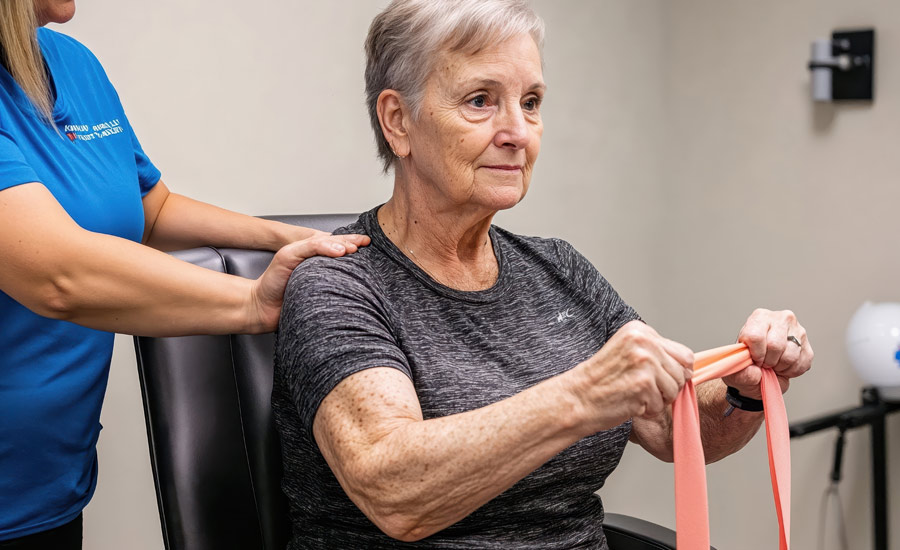The Role of Physical Therapy in Enhancing Quality of Life in Care Homes

Research indicates that care home residents spend approximately 79–87% of their time inactive, leading to increased dependency and low mood.
Staying mobile makes everyday life easier, but for many care home residents, illness, injury, or age-related changes can make movement more difficult. Care homes prioritising physical rehabilitation allow residents to stay active, reduce pain and maintain independence longer than they would without it.
This article explores the physical therapies available in modern care homes and how they make a real difference in daily life.
What Physical Rehabilitation Options Are Available in Care Homes?
Care homes provide various rehabilitation services, such as:
- One-on-one physiotherapy sessions for improving strength, flexibility and overall mobility through tailored exercises.
- Occupational therapy helps residents adapt daily movements to make everyday tasks safer and more manageable.
- For those recovering from surgery or illness, structured rehabilitation plans support recovery and rebuild strength at a comfortable pace.
- Balance and fall prevention programs keep residents steady on their feet, reducing the risk of falls and injuries.
- Seated and assisted exercise sessions offer gentle, low-impact movement options for those with limited mobility, making sure everyone can stay active regardless of their ability.
- Pain management techniques, including targeted movement therapy, ease stiffness and discomfort, improving overall well-being.
Personalised Therapy Plans for Residents
No two residents have the same mobility levels, health conditions or personal goals, so therapy plans must be flexible and custom to their needs. Rehabilitation works best when it’s built around the individual. A one-size-fits-all approach won’t deliver real results.
Every resident starts with a full assessment by a physiotherapist or rehabilitation specialist. This assessment looks at the resident’s current movement ability, any pain or stiffness they experience, past injuries or surgeries and what they need help with most. Some may want to regain confidence in walking, while others might need support managing arthritis pain or improving balance to prevent falls.
After the assessment, a personalised plan is put in place, including strength exercises, targeted stretching, pain management skills or balance training to help prevent future injuries. This plan will be reviewed regularly and adjusted for continued progress.
To help them get back their strength and mobility post-surgery or illness, residents follow a short-term rehabilitation program at a pace that is best for them. Some have ongoing mobility challenges, so long-term therapy focuses on maintaining movement, preventing stiffness and more injury.
Having a personalised approach means therapy is manageable, suited to each resident’s needs and actually works.
Making Movement Fun and Social
Exercise is always easier when you’re doing it with others and group therapy in care homes makes movement feel more social, engaging and fun. Instead of feeling like a chore, it becomes something to look forward to – a chance to stay active, have a chat and enjoy a bit of company.
These sessions are gentle, accessible and personalised to different abilities, whether a resident is fit and healthy or recovering from an illness. Residents might take part in seated exercise, light resistance training or balance work – all aimed at keeping muscles strong and movement feeling natural. Some homes even add music, interactive games or themed sessions to keep things interesting.
Group therapy offers physical benefits, as well as boosting mental health and motivation, adding structure to the day. Moving together helps residents stick with exercises, stay engaged and feel part of something bigger. There’s no pressure to push too hard – it’s all about doing what feels good and keeping mobility levels up. Technology is also keeping residents independent and healthy in modern care homes.
Whether stretching in a group, joining a chair yoga or just sharing a laugh while working on balance exercises, staying active together makes a big difference, both physically and mentally!
The Role of Care Staff in Supporting Physical Therapy
Rehabilitation doesn’t stop when a therapy session ends. Trained care staff keep residents moving and making exercises part of daily life:
- Encouraging daily movement – Carers work with residents to fit gentle exercises, short walks or stretches into their routines, making movement feel natural rather than forced.
- Reinforcing therapy plans – Physiotherapists set the exercises, but staff ensure residents actually do them by offering reminders, assistance and encouragement throughout the day.
- Hands-on support – Some residents need assistance with transfers, posture adjustments or mobility aids to move safely and comfortably.
- Monitoring progress – Carers notice small changes in strength, balance or discomfort and communicate these to therapists to adjust therapy plans when needed.
- Creating confidence – A positive attitude makes all the difference. Encouragement, reassurance and celebrating small wins help residents stay engaged with therapy.
- Making movement feel normal – Exercise doesn’t have to be a big event. So staff find simple ways to build movement into daily life, whether that’s walking around the garden or stretching before bed.
Lasting Benefits of Physical Therapy
Thanks to rehabilitation in care homes, residents have the tools to stay comfortable, capable and in control of their everyday lives.
The right approach to physical therapy prevents decline, supports recovery and makes daily life easier. By combining professional therapy with ongoing support from staff and families, care home residents can keep moving in a way that works for them.
Ready to explore...
